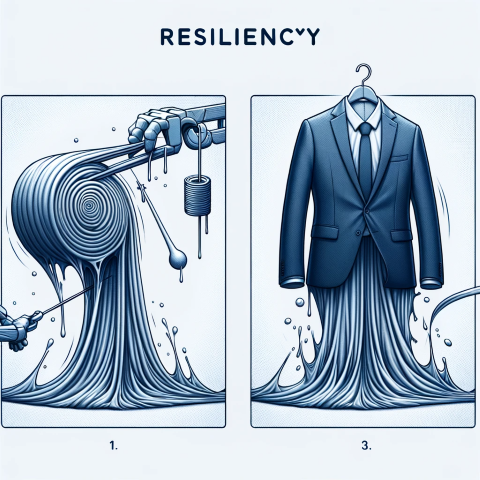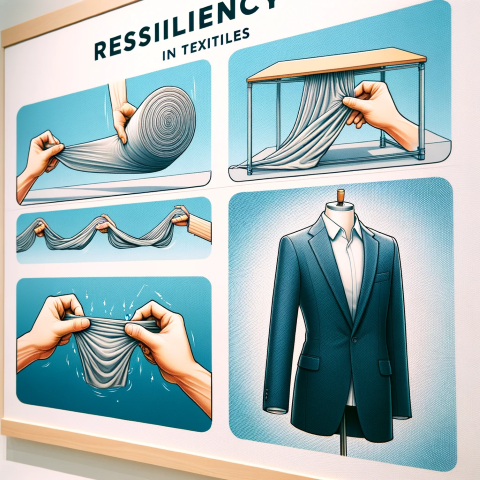Last Updated on: 09-Mar-2024 (4 months, 18 days ago)
Share on Facebook • Share on Twitter
The resiliency of a textile material depends on its fiber type, structure, and processing. Natural fibers like wool and silk are known for their high resiliency due to their natural crimp and elasticity, while cotton and linen have lower resiliency. Synthetic fibers like polyester and nylon can also exhibit good resiliency depending on their processing and weaving techniques.
Several factors can affect the resiliency of a fabric, including the weave pattern, yarn size, twist, and finishing treatments. Tighter weaves and higher twist yarns tend to produce fabrics with better resiliency, while looser weaves and lower twist yarns can result in less resilient fabrics. Additionally, finishing treatments like heat-setting, chemical treatments, and mechanical stretching can enhance the resiliency of a fabric.
Resiliency is a key factor in many applications of textile materials, including apparel, home furnishings, and industrial textiles. In apparel, fabrics with good resiliency are preferred for garments that need to retain their shape after repeated wear, such as suits, dresses, and sportswear. Home furnishing fabrics like upholstery and drapery require good resiliency to maintain their appearance and prevent sagging or stretching over time.
In the industrial textile sector, resiliency is important in products like automotive textiles, geotextiles, and medical textiles. Automotive textiles like seat covers and headliners need to retain their shape and appearance even after prolonged exposure to heat and humidity. Geotextiles used in civil engineering applications require good resiliency to maintain their strength and integrity over time. Medical textiles like compression stockings and orthopedic braces rely on good resiliency to provide consistent pressure and support to the body.
Manufacturers of textile materials use various techniques to improve the resiliency of their products. For example, heat-setting is a common finishing treatment used to enhance the resiliency of synthetic fibers like polyester and nylon. This involves subjecting the fabric to high temperatures and pressure to permanently set its shape and size. Chemical treatments like crosslinking and resin finishing can also improve the resiliency of textile materials by modifying their molecular structure.
Top manufacturers of textile materials that emphasize resiliency in their products include DuPont, Toray Industries, Inc., and INVISTA. DuPont is known for its innovative synthetic fibers, including Lycra, which exhibits excellent resiliency due to its high elasticity. Toray Industries, Inc. is a Japanese company that produces a wide range of synthetic fibers, including nylon, polyester, and polypropylene, with different levels of resiliency depending on the application. INVISTA is a global manufacturer of synthetic fibers and polymers, including nylon and polyester, with a strong focus on durability and performance.
In conclusion, resiliency is a critical property in textile materials that affects their durability, performance, and appearance. Fabrics with good resiliency can maintain their shape and structure over time, while fabrics with poor resiliency may develop sagging, puckering or stretching. Various factors like fiber type, weave pattern, yarn size, twist, and finishing treatments can affect the resiliency of a fabric. Manufacturers of textile materials use different techniques to improve the resiliency of their products, with companies like DuPont, Toray Industries, Inc., and INVISTA leading the way in innovation and performance.
Ability of a fiber to spring back to its natural position after folding, creasing or deformation. Loft is related to resiliency; it is the ability to return to original thickness after being compressed. Loft is also known as compressional resiliency.
Some more terms:
Kodel Unraveled: A Textile Revolution Worth Its Weight in Gold
Kodel in Textiles: A Deep Dive into Fiber InnovationIntroductionUnderstanding the evolution of textiles requires a scientific lens to appreciate the intricacies of fiber innovation. Kodel, a...
Read about KodelGrey Goods
A fabric in the condition in which it leaves the loom or knitting machine, i.e. before any bleaching, dyeing or finishing treatment has been given to it. NOTE: In some countries, particularly on the...
Read about Grey GoodsDoctor Blade
A straight-edge whose function is to remove surplus material (e.g. filling, coating material, printing paste) from the surface of the rollers used to apply the material or from a fabric surface to...
Read about Doctor BladeLoose
In the textile industry, "loose" is a term used to describe a fabric's weave or knit structure that is characterized by a relatively low density of yarns per unit area. Loose fabrics are airy and...
Read about LooseWeaving Wonders: Unraveling the Art of Fabric Interlacing
Weaving: Unraveling the Art of Interlacing ThreadsThe Intricate Tapestry of Weaving and Its Evolution Through TimeWeaving, an age-old textile technique, involves the interlacing of warp and weft...
Read about WeavingSand wash
In the world of textiles, the sand wash technique is a unique and fascinating process used to achieve a distinct aesthetic and texture on fabrics. This article aims to provide a comprehensive...
Read about Sand washFabric: From Looms to Labs, a Journey Through Time
A manufactured assembly of fibres or yarns (or both) that has substantial surface area in relation to its thickness, and sufficient mechanical strength to give the assembly inherent cohesion. NOTE:...
Read about FabricCarbonisation
A chemical process for eliminating vegetable matter from animal fibres such as wool by degrading it to an easily friable (readily crumbled) condition. The process usually involves treatment with an...
Read about CarbonisationAdd a definition
- The term you want to define
- Its definition in 500 words or less
- Attach an image if necessary.
- Optionally, tell us about yourself in 200 words or less!
Companies for Resiliency:
- Company name
- Company address
- Attach a logo, if necessary.
- Optionally, tell us about yourself in 200 words or less!

 South Carolina is home to some of the largest textile companies in the US.
South Carolina is home to some of the largest textile companies in the US.

